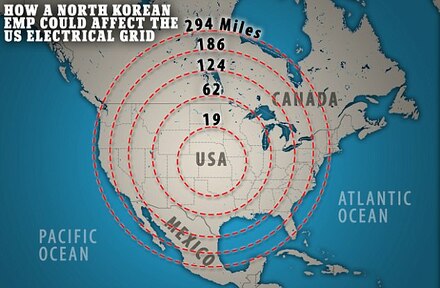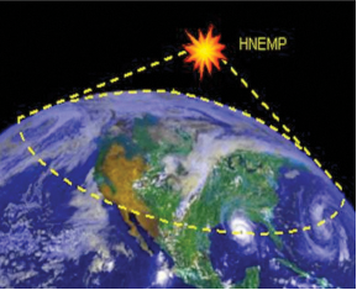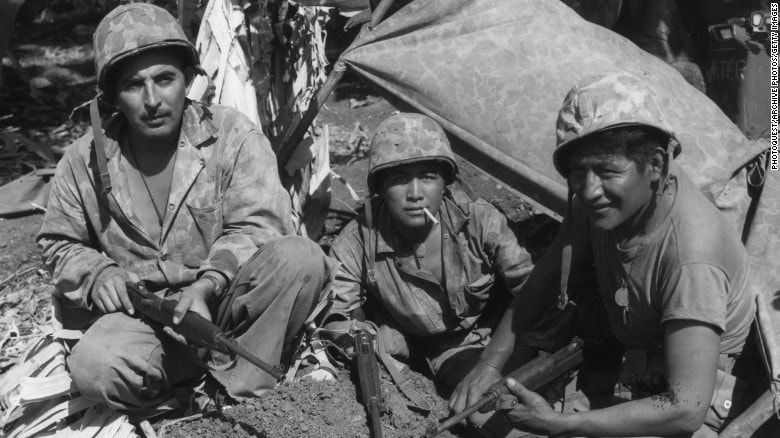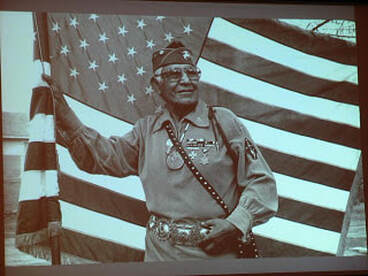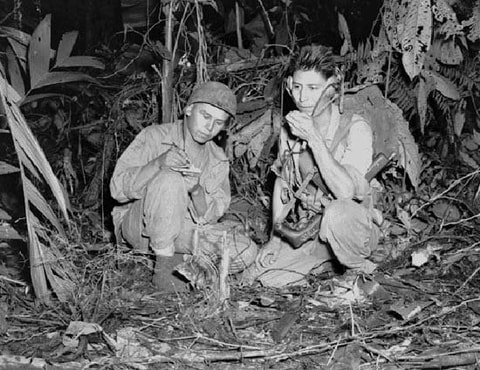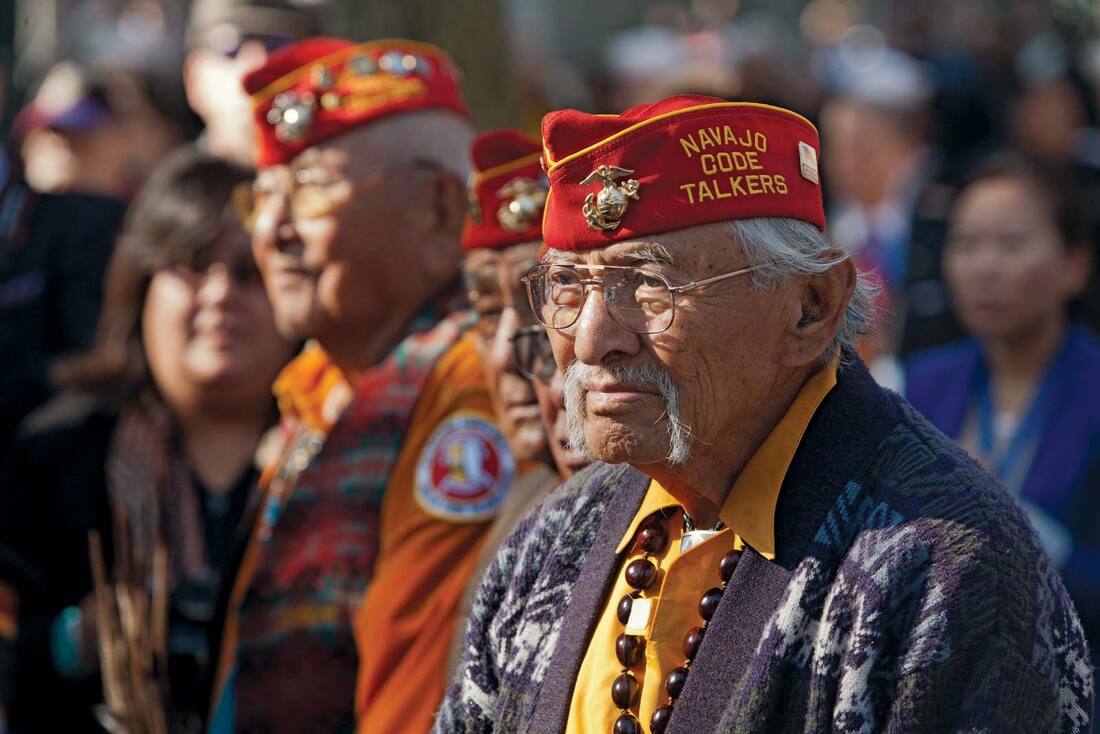Potential Threat #1: EMP -- electromagnetic pulse
Former CIA Director R. James Woolsey has been saying for years that North Korea is capable of carrying out a high-altitude electromagnetic pulse (EMP) attack against the United States.
Such an attack, Woolsey warns, could blackout the national electric grid and other life-sustaining critical infrastructures for over a year--killing 9 of 10 Americans by starvation and societal collapse.
Let me repeat that: Woolsey estimated that nine out of ten Americans might die! In March 2019, in TheHill.com, he and Dr. Peter Vincent Pry wrote: "Two North Korean satellites, the KMS-3 and KMS-4, presently orbit over the U.S. on trajectories consistent with surprise EMP attack." See: https://thehill.com/blogs/pundits-blog/defense/326094-how-north-korea-could-kill-up-to-90-percent-of-americans-at-any
Woolsey and others believe that Iran, too, may be capable of such an attack: “And at a time of its choosing, Iran could launch a surprise EMP (electromagnetic pulse) attack against the United States by satellite, as they have apparently practiced with help from North Korea.” See: https://thehill.com/opinion/national-security/419569-dont-trust-the-intel-when-it-comes-to-irans-nuke-program
Woolsey and others believe that Iran, too, may be capable of such an attack: “And at a time of its choosing, Iran could launch a surprise EMP (electromagnetic pulse) attack against the United States by satellite, as they have apparently practiced with help from North Korea.” See: https://thehill.com/opinion/national-security/419569-dont-trust-the-intel-when-it-comes-to-irans-nuke-program
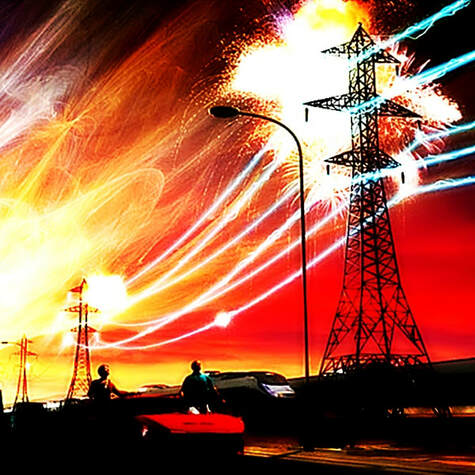
Some scientists and engineers believe that the detonation of one or more atomic bombs high above the surface of the American homeland would generate a powerful electromagnetic pulse. This pulse would quickly strike millions of wires and electronic components across our country, crippling power grids, communication networks, and banking and credit card systems. Many cars, planes, trains, computers, radios and TVs would cease to function.
Systems for supplying water to many of our cities and towns would be disabled, since these rely on electric pumps. Systems for the removal of sewage might be immobilized. Freezers and refrigerators would shut down, spoiling much of our food reserves. Pharmacies would quickly run out of medicines. Looting would be widespread as law enforcement resources are stretched to the breaking point.
Systems for supplying water to many of our cities and towns would be disabled, since these rely on electric pumps. Systems for the removal of sewage might be immobilized. Freezers and refrigerators would shut down, spoiling much of our food reserves. Pharmacies would quickly run out of medicines. Looting would be widespread as law enforcement resources are stretched to the breaking point.
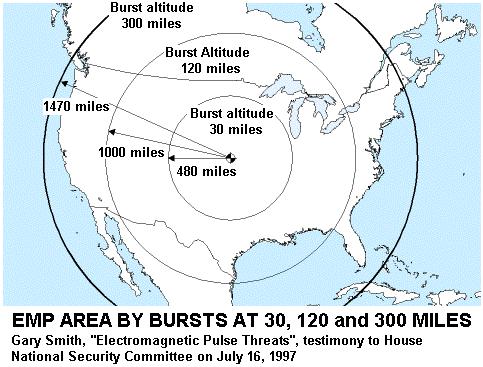
During the Cold War, the US military feared that such an EMP attack could be launched by the Soviet Union. Today, several bad actors threaten us. New and highly unstable players have acquired, or are attempting to acquire, nuclear weaponry. Thus, we face the possibility that a state with a mentally unbalanced leader, or one driven by some apocalyptic prophecy, might someday unleash a nuclear attack.
Once, we thought that Mutually Assured Destruction would inhibit such an assault. But would ISIS or Al Qaeda fear retaliation if they could buy or steal an EMP weapon and a delivery device such as a private jet? Are the leaders of North Korea and Iran sane enough to keep their hatred of us in check?
Solar Wind

Some scientists believe that a completely natural event -- for instance, a solar super-storm -- could cause havoc similar to that produced by an EMP bomb.
On September 1, 1859, an English amateur astronomer named Richard C. Carrington observed an eruption on the surface of the sun -- a giant solar flare.
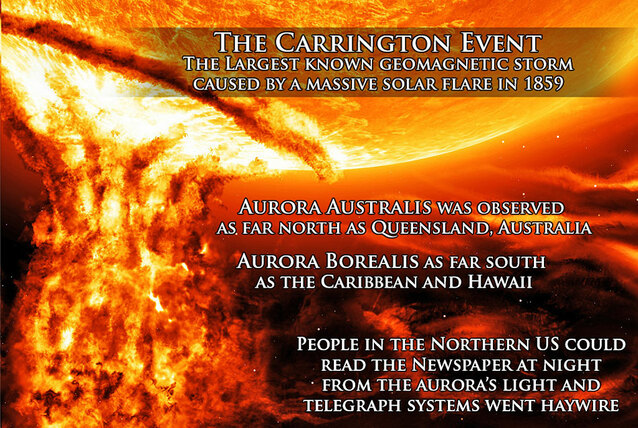
The Carrington Event
What happened two days later is now called the “Carrington Event” -- the solar storm reached Earth, attacking our planet's magnetic field, and damaged many telegraph systems across Europe and North America. Wires overheated, melted, and sparked; and some operators received electric shocks.
One difference between a huge solar storm hitting Earth today and an EMP strike is this: the storm's effects could be worldwide. In 2012, there was a solar storm of Carrington magnitude, but as the great flare shot out into space and reached the Earth's orbit on July 23, it missed us -- the Earth had been at that intersection point in its orbit about a week before. Some scientists believe that a storm of such intensity has about a 10 percent probability of occurring during any given decade. Thus, sooner or later, our complex power and communication grids are going to be assailed by a natural solar storm.
What happened two days later is now called the “Carrington Event” -- the solar storm reached Earth, attacking our planet's magnetic field, and damaged many telegraph systems across Europe and North America. Wires overheated, melted, and sparked; and some operators received electric shocks.
One difference between a huge solar storm hitting Earth today and an EMP strike is this: the storm's effects could be worldwide. In 2012, there was a solar storm of Carrington magnitude, but as the great flare shot out into space and reached the Earth's orbit on July 23, it missed us -- the Earth had been at that intersection point in its orbit about a week before. Some scientists believe that a storm of such intensity has about a 10 percent probability of occurring during any given decade. Thus, sooner or later, our complex power and communication grids are going to be assailed by a natural solar storm.

A Possible Defense
Many scientists and military experts believe we need to take quick action to harden our power lines, computers, etc. against EMP threats from our adversaries and from nature. They say we should stockpile key electrical components, train personnel, and upgrade our still-primitive ABM (anti-ballistic missile) system.
In response to those concerns, on March 26, 2019, President Trump issued an “Executive Order on Coordinating National Resilience to Electromagnetic Pulses” which requires that: “The Federal Government must foster sustainable, efficient, and cost-effective approaches to improving the Nation’s resilience to the effects of EMPs.”
Not Everyone Agrees
Interestingly, not everyone agrees that EMP bombs pose a catastrophic threat to our nation. American physicist Mario Rabinowitz wrote a paper entitled "Effect of the Fast Nuclear Electromagnetic Pulse on the Electric Power Grid Nationwide: A Different View" It was originally published in 1987, in the IEEE Transactions on Power Delivery, and revised in 2003. This paper concluded that EMP is no more harmful to the power grid than its counterparts in nature such as lightning storms, partly because the ionization produced by a nuclear burst severely reduces the force and the effect of the EMP.
Who ya gonna believe?
* * *
Many scientists and military experts believe we need to take quick action to harden our power lines, computers, etc. against EMP threats from our adversaries and from nature. They say we should stockpile key electrical components, train personnel, and upgrade our still-primitive ABM (anti-ballistic missile) system.
In response to those concerns, on March 26, 2019, President Trump issued an “Executive Order on Coordinating National Resilience to Electromagnetic Pulses” which requires that: “The Federal Government must foster sustainable, efficient, and cost-effective approaches to improving the Nation’s resilience to the effects of EMPs.”
Not Everyone Agrees
Interestingly, not everyone agrees that EMP bombs pose a catastrophic threat to our nation. American physicist Mario Rabinowitz wrote a paper entitled "Effect of the Fast Nuclear Electromagnetic Pulse on the Electric Power Grid Nationwide: A Different View" It was originally published in 1987, in the IEEE Transactions on Power Delivery, and revised in 2003. This paper concluded that EMP is no more harmful to the power grid than its counterparts in nature such as lightning storms, partly because the ionization produced by a nuclear burst severely reduces the force and the effect of the EMP.
Who ya gonna believe?
* * *
Potential threat #2: nuclear arsenals of adversaries
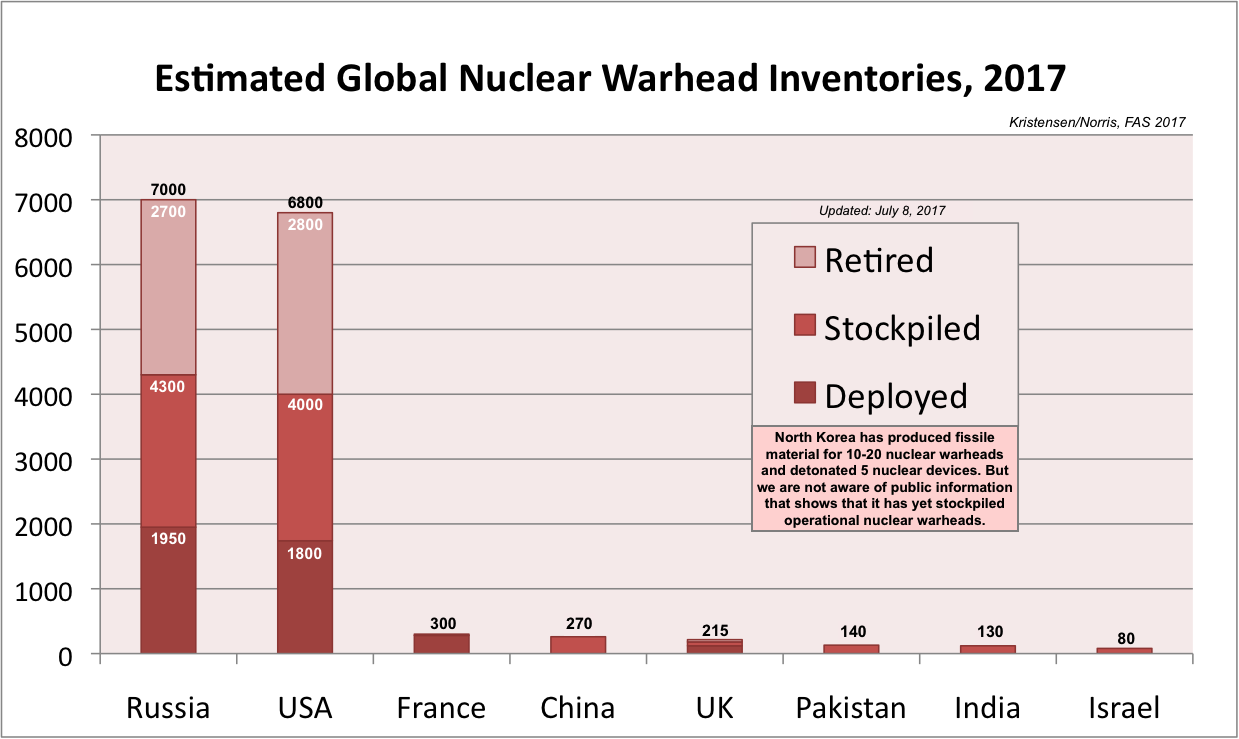
Russia has an estimated 7,000 nuclear warheads in its arsenal. Approximately 5,000 of them may be classified as "tactical", many of those "precision low yield". Russian warheads can be deployed on bombers, land-based ICBMs (inter-continental ballistic missiles), submarine-based missiles, and on their newly developed hypersonic missiles.
 Russia's Tsirkon hypersonic missile.
Russia's Tsirkon hypersonic missile.
Their Tsirkon (Zircon) hypersonic missiles could be used to launch surprise strikes against the U.S. national command authority (the President, senior military leaders, and the nuclear command and control system).
A hypersonic missile is one that can travel at least five times the speed of sound (5 x 767 mph = 3835 mph). A retired Russian admiral has said that the Tsirkon would be capable of hitting command posts in the U.S. within five minutes from Russian submarines. Five minutes! -- not much time to react. See: https://nationalinterest.org/blog/buzz/russias-massive-nuclear-weapons-arsenal-threat-59947?page=0%2C2
China has approximately 270 nuclear warheads. The U.S. Department of Defense 2013 report to Congress on China's military developments stated that the Chinese nuclear arsenal consists of 50–75 ICBMs, located in both land-based silos and on ballistic missile submarine platforms. They also have a number of medium-range and short-range ballistic missiles, as well as cruise missiles, and they are developing a hypersonic missile.
The Chinese have at least 300 bombers and fighter bombers capable of carrying nuclear warheads; among that number are 100 advanced Sukhoi Su-30 bombers which they bought from Russia.
Interestingly, China apparently stores many of its missiles in huge underground tunnel complexes, possibly in excess of 3,000 miles in total length. These tunnels are also used to transport various types of forces in secret. The Chinese Army newsletter calls this tunnel system an "underground Great Wall of China";
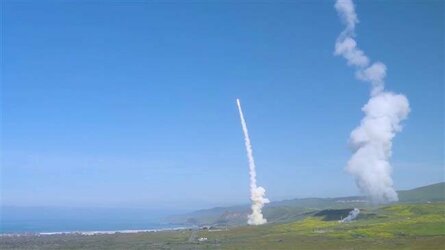 (Missile Defense Agency photo/Lisa Simunaci)
(Missile Defense Agency photo/Lisa Simunaci)
Pentagon: Missile Defense Test Succeeds in Shootdown
26 Mar 2019
The Tribune (San Luis Obispo, Calif.) | By Gabby Ferreira and Kaytlyn Leslie
The United States Missile Defense Agency fired interceptor missiles from Vandenberg Air Force Base on Monday in a successful first-of-its-kind test of the nation's missile defense program.
The test was meant to practice how well the U.S. military could respond in the event of a missile being shot from another country like North Korea or Iran.
Officials said the two interceptor missiles -- which were launched at around 10:30 a.m. -- hit their target.
Shortly after the launch, twin contrails could be seen in the sky over the region.
The Department of Defense said an intercontinental ballistic missile was shot from the Reagan Test Site on Kwajalein Atoll in the Republic of the Marshall Islands about 4,000 miles away, which acted as a dummy target for the interceptors shot from Vandenberg Air Force Base. The missile was successfully intercepted, according to a DoD news release.
"This was the first GBI salvo intercept of a complex, threat-representative ICBM target, and it was a critical milestone," MDA Director Air Force Lt. Gen. Samuel A. Greaves said in a news release Monday afternoon. "The system worked exactly as it was designed to do, and the results of this test provide evidence of the practicable use of the salvo doctrine within missile defense."
* * *
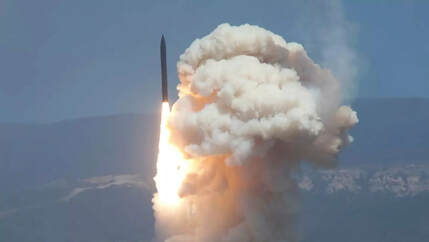
Homeland Missile Defense System Successfully Intercepts ICBM Target
-- U.S. Department of Defense - Missile Defense AgencyMissile Defense AgencyMDA News Release
March 25, 2019
The U.S. Missile Defense Agency, in cooperation with the Joint Functional Component Command for Integrated Missile Defense, U.S. Northern Command, and elements of the U.S. Air Force Space Command’s 30th, 50th, and 460th Space Wings, conducted a successful test today against an Intercontinental Ballistic Missile (ICBM) class target....
...The GBI-Lead destroyed the reentry vehicle, as it was designed to do. The GBI-Trail then looked at the resulting debris and remaining objects, and, not finding any other reentry vehicles, selected the next ‘most lethal object’ it could identify, and struck that, precisely as it was designed to do...
... the Exo-atmospheric Kill Vehicles successfully engaged the target complex, resulting in an intercept of the target...
...The mission of the Missile Defense Agency is to develop and deploy a layered ballistic missile defense system to defend the United States, its deployed forces, allies and friends from limited ballistic missile attacks of all ranges in all phases of flight. Additional information about all elements of the ballistic missile defense system can be found at www.mda.mil.
* * *
Code talkers
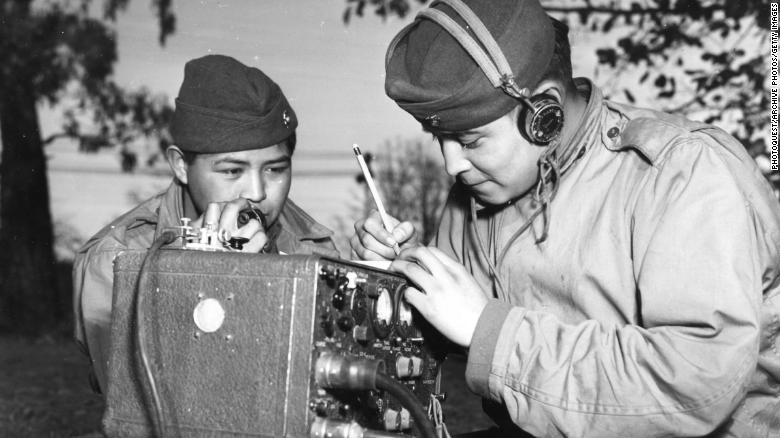
Code Talkers were men employed by the US military during wartime to help keep communications secret.
An officer would give orders or information to a code talker; the code talker would then translate those orders into a little-known language, encode them, and transmit them via military telephone or radio. At the other end of the line, another code talker would decode the message, translate it back into English, and deliver it to other officers or soldiers.
The name "Code Talkers" is strongly associated with Navajo speakers recruited during World War II by the US Marine Corps to serve in Pacific theater.
However, the first known use of code talkers in the US military was during World War I, and it was pioneered by Cherokees and Choctaws. Cherokee soldiers of the US 30th Infantry Division were assigned to transmit messages while under fire during the Second Battle of the Somme in September 1918. Choctaw men in the Army's 36th Infantry Division used their language to help the American Expeditionary Forces in several battles of the Meuse-Argonne Offensive in October of that year.
The idea for using the Navajo language as a code originated with a man named Philip Johnston (born September 17, 1892). The son of a missionary, he grew up on the Navajo reservation in Arizona and learned to speak Navajo there. In World War I, Johnston served in France with the U.S. Army's 319th Engineers, and it is there that he may have heard about Indians being used as code talkers by U.S. Army units. When World War II broke out, Johnston convinced the Marine Corps that the Navajo language -- a highly complex language understood by only 30 or so non-Navajo people in the world -- could be used as the basis for a code that was unbreakable, reliable, and fast.
In May 1942 the first 29 Navajo Code Talkers were recruited, and two types of code were developed. The first type was an alphabetic code -- a number of Navajo words each stood for the letter A, other words stood for the letter B, etc. For example, Moasi (Cat) stood for the letter C; Tkin (Ice) stood for the letter I. The second type of code used Navajo words to stand for common military terms -- Gini (chicken-hawk) meant dive bomber; Lo-tso (whale) meant battleship, etc. Soon, more than 450 frequently used military terms were given Navajo equivalents.
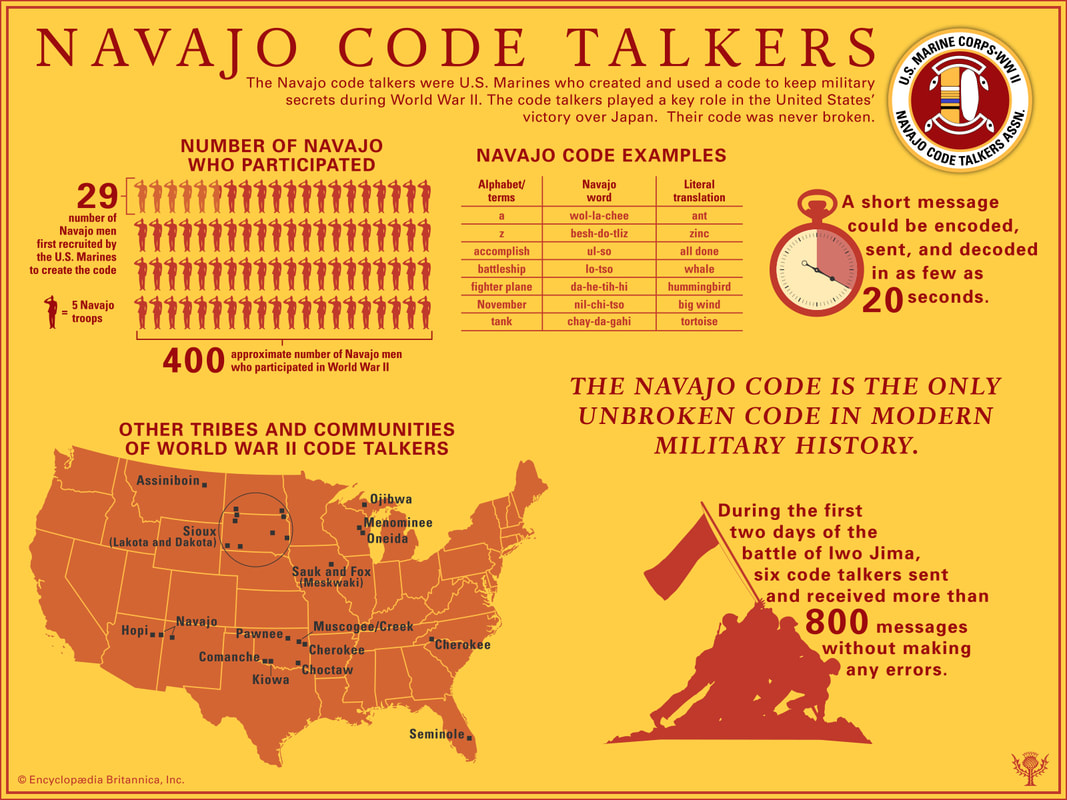
US Navy Navajo Code
Below is the United State Navy Navajo alphabetic code as of June 15, 1945, followed by a sample of the military terms code. This code was declassified per US Department of Defense Directive 5200.9 in 1968.
The entire Code Talkers' Dictionary may be found at: https://www.history.navy.mil/research/library/online-reading-room/title-list-alphabetically/n/navajo-code-talker-dictionary.html
ALPHABET NAVAJO WORD LITERAL TRANSLATION
A WOL-LA-CHEE ANT
A BE-LA-SANA APPLE
A TSE-NILL AXE
B NA-HASH-CHID BADGER
B SHUSH BEAR
B TOISH-JEH BARREL
C MOASI CAT
C TLA-GIN COAL
C BA-GOSHI COW
D BE DEER
D CHINDI DEVIL
D LHA-CHA-EH DOG
E AH-JAH EAR
E DZEH ELK
E AH-NAH EYE
F CHUO FIR
F TSA-E-DONIN-EE FLY
F MA-E FOX
G AH-TAD GIRL
G KLIZZIE GOAT
G JEHA GUM
H TSE-GAH HAIR
H CHA HAT
H LIN HORSE
I TKIN ICE
I YEH-HES ITCH
I A-CHI INTESTINE
J TKELE-CHO-G JACKASS
J AH-YA-TSINNE JAW
J YIL-DOI JERK
K JAD-HO-LONI KETTLE
K BA-AH-NE-DI-TININ KEY
K KLIZZIE-YAZZIE KID
L DIBEH-YAZZIE LAMB
L AH-JAD LEG
L NASH-DOIE-TSO LION
M TSIN-TLITI MATCH
M BE-TAS-TNI MIRROR
M NA-AS-TSO-SI MOUSE
N TSAH NEEDLE
N A-CHIN NOSE
O A-KHA OIL
O TLO-CHIN ONION
O NE-AHS-JAH OWL
P CLA-GI-AIH PANT
P BI-SO-DIH PIG
P NE-ZHONI PRETTY
Q CA-YEILTH QUIVER
R GAH RABBIT
R DAH-NES-TSA RAM
R AH-LOSZ RICE
S DIBEH SHEEP
S KLESH SNAKE
T D-AH TEA
T A-WOH TOOTH
T THAN-ZIE TURKEY
U SHI-DA UNCLE
U NO-DA-IH UTE
V A-KEH-DI-GLINI VICTOR
W GLOE-IH WEASEL
X AL-NA-AS-DZOH CROSS
Y TSAH-AS-ZIH YUCCA
Z BESH-DO-TLIZ ZINC
AIRCRAFT NAVAJO WORD LITERAL TRANSLATION
PLANES WO-TAH-DE-NE-IH AIR FORCE
DIVE BOMBER GINI CHICKEN HAWK
TORPEDO PLANE TAS-CHIZZIE SWALLOW
OBS. PLAN NE-AS-JAH OWL
FIGHTER PLANE DA-HE-TIH-HI HUMMING BIRD
BOMBER PLANE JAY-SHO BUZZARD
PATROL PLANE GA-GIH CROW
TRANSPORT ATSAH EAGLE
SHIPS NAVAJO WORD LITERAL TRANSLATION
SHIPS TOH-DINEH-IH SEA FORCE
BATTLESHIP LO-TSO WHALE
AIRCRAFT TSIDI-MOFFA-YE-HI BIRD CARRIER
SUBMARINE BESH-LO IRON FISH
MINE SWEEPER CHA BEAVER
DESTROYER CA-LO SHARK
TRANSPORT DINEH-NAY-YE-HI MAN CARRIER
CRUISER LO-TSO-YAZZIE SMALL WHALE
MOSQUITO BOAT TSE-E MOSQUITO
PLANES WO-TAH-DE-NE-IH AIR FORCE
DIVE BOMBER GINI CHICKEN HAWK
TORPEDO PLANE TAS-CHIZZIE SWALLOW
OBS. PLAN NE-AS-JAH OWL
FIGHTER PLANE DA-HE-TIH-HI HUMMING BIRD
BOMBER PLANE JAY-SHO BUZZARD
PATROL PLANE GA-GIH CROW
TRANSPORT ATSAH EAGLE
SHIPS NAVAJO WORD LITERAL TRANSLATION
SHIPS TOH-DINEH-IH SEA FORCE
BATTLESHIP LO-TSO WHALE
AIRCRAFT TSIDI-MOFFA-YE-HI BIRD CARRIER
SUBMARINE BESH-LO IRON FISH
MINE SWEEPER CHA BEAVER
DESTROYER CA-LO SHARK
TRANSPORT DINEH-NAY-YE-HI MAN CARRIER
CRUISER LO-TSO-YAZZIE SMALL WHALE
MOSQUITO BOAT TSE-E MOSQUITO
Somewhere between 400 and 500 Native American Code Talkers served in the Marines in the Pacific Theater. The Code Talkers were a part of every major Marine assault during the Second World War from Guadalcanal (August 1942) onward, including Iwo Jima, Peleliu, and Tarawa. Countless lives were saved by their quick, accurate coding and de-coding, often performed under fire.
It is interesting to note that German authorities knew about the use of code talkers during World War I; before the outbreak of World War II, they sent a team of thirty anthropologists to the United States to learn Native American languages. However, the task proved too difficult because of the array of native languages and dialects.
During WWII, the United States Army utilized code talkers from various tribes, including Assiniboine, Hopi, Lakota, Meskwaki, Mohawk, Comanche, and Tlingit. These soldiers served in the Pacific, North African, and European theaters. One example: thirteen Comanche code talkers took part in the Invasion of Normandy (June 6, 1944).
The important work of the code talkers was kept secret until many years after World War II.
* * *
So, why mention the Code Talkers here, on this site about the novel Defense Mechanism? Well, in the novel, Johnnie Lonetree's great-grandfather had been a Navajo Code Talker, and the story of the code talkers had a big influence on Johnnie's life.
* * *
Navajo code talker dies
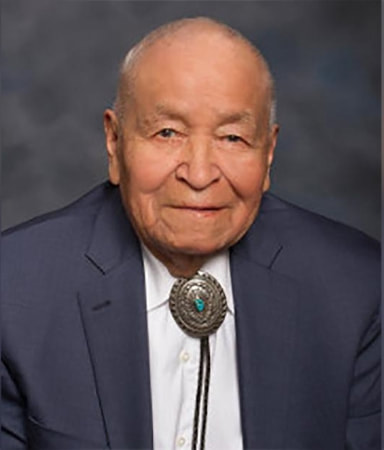 John Pinto, Navajo Code Talker.
John Pinto, Navajo Code Talker.
John Pinto, a Navajo code talker during World War II, died in Gallup, New Mexico, on May 24, 2019 at the age of 94.
Pinto was born in December 1924, in Lupton, Arizona, to a family of Navajo shepherds and grew up in Arizona and New Mexico.
During World War II, he served in the Marine Corps as a code talker — the Native Americans recruited to relay battlefield communications in a spoken code based on their tribal language, which the Germans and Japanese never cracked.
Some 400 Navajo took part in the project, along with members of several other tribes. None of the original 29 code talkers who invented the language are still alive. The last, Chester Nez, died in 2014.
After World War II, Pinto went on to a long career as a teacher and a Democratic state lawmaker in New Mexico. Navajo Nation President Jonathan Nez hailed Pinto as a “great Dine warrior” who “dedicated his life to helping others.”
“The debt we owe for that service, and the service of all Code Talkers, can never be repaid,” New Mexico Governor Michelle Lujan Grisham said in a statement. Grisham ordered all state flags to fly at half-staff in Pinto’s honor.
* * *
Other topics to discuss:
Reagan's Strategic Defense Initiative (SDI)
Anti-Ballistic Missiles (ABM)
Drones, satellites and spy cams
NSA surveillance
Reagan's Strategic Defense Initiative (SDI)
Anti-Ballistic Missiles (ABM)
Drones, satellites and spy cams
NSA surveillance
copyright © Steven J. Maricic 2019
